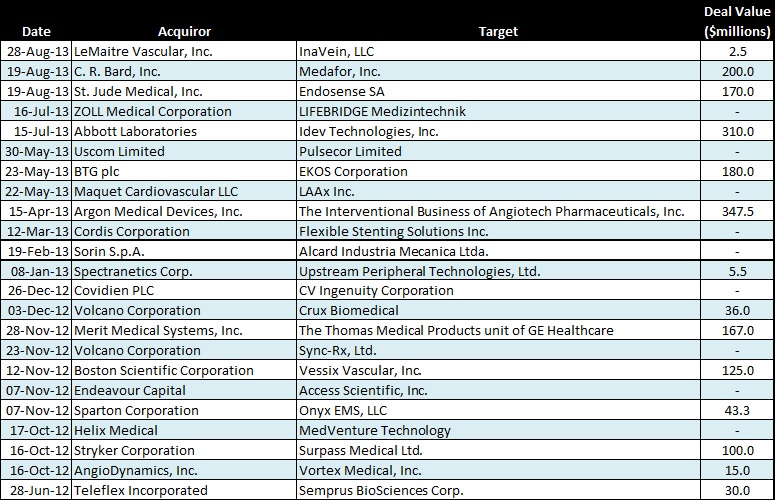Strategic Healthcare Mergers and Acquisitions (M&A)
Vascular Access Trends
10/28/2013
Vascular Access Industry Trends
The Walden Group's assessment of vascular access market dynamics:
- Growing Market and Changing Demographics
In 2012, the U.S. market for vascular access devices was worth an estimated $4 billion – a 6.1% increase over the previous year. The market is expected to continue to grow at a high-single-digit rate and exceed $6 billion by 2019 in the U.S. alone*. The aging population and increased prevalence of diabetes and obesity has put more Americans at risk for renal disease, among other illnesses, contributing to the growing market. - Advanced and Safer Catheter Systems
New catheter tracking systems use infrared and ultrasound for imaging and visualization. It is gaining popularity in the market due to its non-invasive, direct real-time vascular structure accessibility. Also, catheters incorporating antimicrobial technologies are becoming common to reduce CRBSI. - Less-Invasive Methods
Hypodermoclysis, the subcutaneous infusion of fluids hydration technique, is becoming a more common non-invasive alternative to intravenous hydration for certain dehydrated adult patients due to its safety and ease of administration. In certain instances, absorption of fluid via the subcutaneous route is as effective as that of the intravenous route. - CMS Reimbursement Changes
CMS does not reimburse over and above Inpatient Prospective Payment System (IPPS) rate for care required to prevent several types of hospital acquired infection. Hospitals will not receive additional payment for cases in which a catheter-associated infection was not present on admission. The average cost to treat a catheter related bloodstream infection (CRBSI) is $0.91m and the average reimbursement is about $0.67m – an operational loss of $0.24m. As of Oct. 1, 2008, reimbursement will be zero. - Healthcare-Associated or Hospital Acquired Infections (HAIs)
Risk associated with vascular access devices is one of the main contributors to HAIs. A CVC has the greatest risk of acquiring an infection. There is also an Increased risk with the duration of time that the catheter is present and/or in use. “Dialysis catheter-related bloodstream infections arise from either migration of the pathogen from the skin outside of the catheter into the bloodstream or directly from inoculation of a pathogen into the interior lumen of the catheter via the hub or infusion port”. Gram-positive organisms with Staphylococcus aureus and coagulase-negative staphylococcus are the most common pathogens responsible for HAIs which account for ~40-80% of cases. The incidence of Methicillin-resistant Staphylococcus aureus (MRSA) infections in dialysis patients is more than 100 times the incidence in the general population. This is likely due to the capability of the organism to form biofilm on the inner surfaces of indwelling medical devices such as a CVC. - Morbidity and Mortality. There has been a steady increase of patients initiating hemodialysis with a central venous catheter, representing approximately 80% of all incident accesses. There has also been a steady increase in prevalent fistula use, currently greater than 50% within 4 months of hemodialysis initiation. There is a three- to fourfold increase in risk of infectious complications in patients initiating dialysis with a catheter compared with either a fistula or graft and a sevenfold higher risk when the catheter is used as a prevalent access.
Recent Healthcare M&A activity in the Vascular Access Market:


